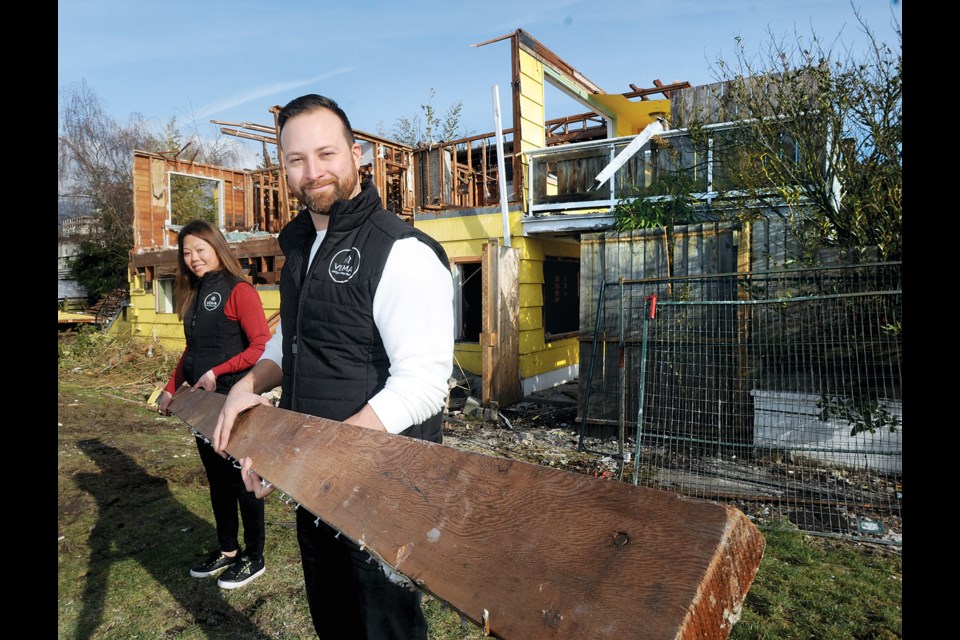It was once the cradle of Jimmy Pattison’s business empire, but today its real value is in “urban mining.”
Over the last week, Pattison’s little yellow house on Argyle Avenue on the West Â鶹´«Ã½Ó³»waterfront has been picked apart to be trucked off the North Shore. Pattison lived in the home in the 1950s when he was working as a car dealer. He used the property as collateral for his first loan when he was going into business for himself.
The municipality as part of a long-standing plan to purchase all of the remaining properties on the Argyle waterfront and convert them into park space.
Initially, the municipality had hoped to see the so it could be but the
When it came time to get rid of the home and get on with the park plans, VEMA Deconstruction won the bid with a uniquely sustainable pitch.
“We’re mining urban resources,” said Erick Serpas Ventura, company co-founder. “All the material that is coming from this project can be upcycled, can be repurposed, can be brought back into the circular economy, can create more jobs. It can create a better community.”
Serpas Ventura, a 10-year Royal Canadian Air Force vet, and his wife Vannarady Lim started VEMA Deconstruction with ambitious plans to make socially and environmentally responsible demolition the norm in B.C.
According to Metro Vancouver, construction and demolition debris makes up a third of all the refuse filling our landfills, but homes like Pattison’s are loaded with valuable materials that can be put back to use.
VEMA will see that the house is disassembled into panels, loaded onto a flatbed truck and taken to a processing site in Burnaby where it will be broken down into wood waste, recyclable materials and salvage lumber.
“Typically in a 2,000-square-foot home, we’re able to salvage 20,000 pounds of lumber,” Serpas Ventura said. “If we’re doing just one home a month… that’s 120,000 board feet of lumber that is available that was not available before.”
Metro Â鶹´«Ã½Ó³»estimates that deconstruction can divert 80 per cent of a home’s materials from the dump.
Homes built between 1940 and 1980, which are now the ones most likely to be up for redevelopment, are the best candidates because the quality and cuts of the wood are better than what you’d find in a lumber yard today, Serpas Ventura said.
But, it’s not so simple as yanking the nails from two-by-fours and dropping them off at a construction site. Wood can’t legally be reused for structural purposes until it’s been regraded by the Canadian Lumber Standards Accreditation Board or the Canadian Wood Council. It’s a layer of red tape deconstruction businesses don’t have to deal with across the border in Washington and Oregon, Serpas Ventura said.
VEMA has been working with UBC’s Materials and Manufacturing Research Institute on a study to better understand how demolition waste can be repurposed.
“We are working really hard to get that end product back into building,” he said.
In this case, the bones of Jimmy Pattison’s old home will be donated to Habitat for Humanity, which can then use it or sell it for flooring or furniture making.
The price won’t be the same as simply bulldozing a structure into a bin and carting it off to the landfill, Serpas Ventura readily admits, but he said in the context of an entire redevelopment project, the cost difference is negligible.
Deconstruction will likely pencil out even more favourably as technology, regulations and tax incentives improve, Serpas Ventura said. But builders may eventually find themselves going that route whether they want to or not.
In 2023, a District of North Â鶹´«Ã½Ó³»bylaw came into effect mandating deconstruction for homes built before 1950. The district usually processes about 100 demolition permits for single-family homes per year, although in the first year of the bylaw being in effect, applications were down significantly and only one met the criteria for mandatory deconstruction, said Caroline Jackson, director of climate action, natural systems, and biodiversity for the district.
VEMA did the job and donated the wood to a First Nation in Northern B.C.
Another deconstruction permit is pending, Jackson said, the district is looking forward to seeing the bylaw result in less waste, less need to harvest new resources and less carbon being emitted in the building industry.
Victoria already had such a bylaw in place, and other municipalities across Metro Â鶹´«Ã½Ó³»are considering their own bylaws, Serpas Ventura said.
Back in West Vancouver, Serpas Ventura said folks walking by the little yellow house over the last week have immediately bought in when they learn what’s happening.
“The house has a soul. The house as a spirit. It has meaning to the community and we shouldn’t be destroying it,” he said.


